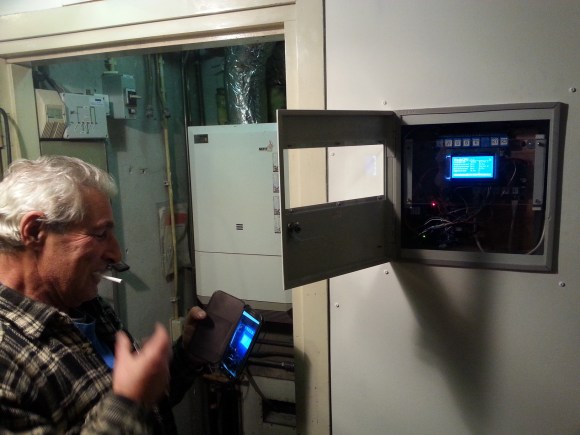
[Michael] is a Scout Leader in the Netherlands, where they have a great clubhouse—a “Landhuis.” The only problem? It’s old, and it’s not an efficient place to heat!
The building currently has two furnaces to cope with its many nooks and crannies, with individual thermostats in each of the five rooms. If a thermostat was activated in one of the rooms, it would control a valve in the furnace responsible for that room. Depending on which valve the furnace is attached to, a furnace would start. As you can imagine, this is an extremely inefficient system if you are heating two different rooms (and using two different furnaces!) It’s all on or off with no in-between.
As true scouts, they try to adhere to the simple principle of “why buy it when you can build it?” Commercial systems are expensive, and besides, they needed a project to work on! They’ve designed a smart(er) system using an Arduino Mega 2560 with five DS18B20 temperature sensors set up in each room, and even threw together a nice enclosure for it! They’ve included the source code on GitHub (in Dutch), so if you’re interested in setting up something similar you can check it out.
[Michael] will be around in the comments section, so if you have any feedback or questions, let him know!















Am I missing something? They didn’t appear to solve the problem of both furnaces turning on for one room each. I would have put both systems in parallel (probably replacing the two pumps with one bigger one), and only turn on the second furnace when so many rooms call for heat. You can have as fancy a thermostat as you want, but it doesn’t help when you have two separate systems.
That said, this is a neat project. I thought about doing something similar in my last (much bigger) house.
hopefully a simple question here. Have you checked to see if there are any duct baffles? if it does an addition to this project might be to add stepper controlled baffle (or something to open and close them) controls or even if they are not installed at this point they would not be huge investment. you would then not only be able to control the furnaces but also which rooms actually get heated.
Thanks for the compliments :)
To answer both questions, the two furnaces are connected in parralel and the new system only turns on the second furnace when the score is high enough (stookscore in the sourcecode). Small rooms add 1 to the score, bigbrooms add 2. At a score of 5 the second furnace turns on.
As for the baffles, each room has its own valve controlled by a relay in the system. So if a room doesn’t ask for heatn the valve stays closed and the room will not be heated.
I hope this answers your questions :)
Thanks for the compliments :)
To answer both questions, the two furnaces are connected in parralel and the new system only turns on the second furnace when the score is high enough (stookscore in the sourcecode). Small rooms add 1 to the score, bigbrooms add 2. At a score of 5 the second furnace turns on.
As for the baffles, each room has its own valve controlled by a relay in the system. So if a room doesn’t ask for heatn the valve stays closed and the room will not be heated.
I hope this answered your questions :)
To eleborate the text above. In the old system a microswitch in the valve turned on the furnace it was linked to by signal wire. Two rooms (the bigger two) were linked to one furnace, the other three to the other furnace. The pipes to the furnaces were already one system.
It would seem that the root problem being a drafty building, looking at fixing the insulation or reinsulating would be the thing to do first. The source article didn’t mention if they looked into that at all.
This. 99% of the time fixing air leaks and insulation will deliver the largest gains.
@JRDM
Of course we are fixing (and have fixed) a lot of the isolation of the building.
But because of the nature of the building itself we can’t make it entirely insulated. (big single layer glass windows, no insulation between the inner and outer walls)